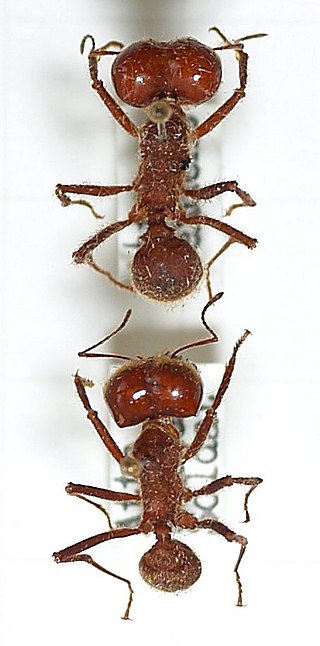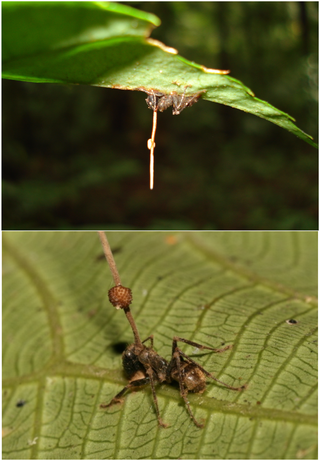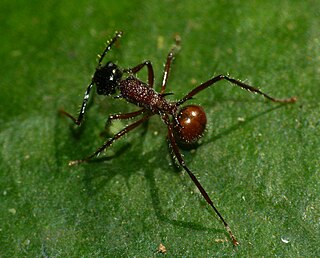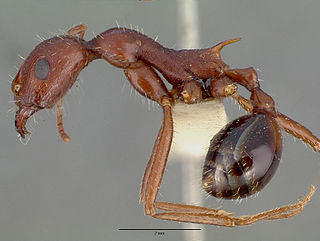
Ants are eusocial insects of the family Formicidae and, along with the related wasps and bees, belong to the order Hymenoptera. Ants evolved from vespoid wasp ancestors in the Cretaceous period. More than 13,800 of an estimated total of 22,000 species have been classified. They are easily identified by their geniculate (elbowed) antennae and the distinctive node-like structure that forms their slender waists.

Leafcutter ants are fungus-growing ants that share the behaviour of cutting leaves which they carry back to their nests to farm fungus. Next to humans, leafcutter ants form some of the largest and most complex animal societies on Earth. In a few years, the central mound of their underground nests can grow to more than 30 m (98 ft) across, with smaller radiating mounds extending out to a radius of 80 m (260 ft), taking up 30 to 600 m2 and converted into 3.55 m individuals.

Fungus-growing ants comprise all the known fungus-growing ant species participating in ant–fungus mutualism. They are known for cutting grasses and leaves, carrying them to their colonies' nests, and using them to grow fungus on which they later feed.

Myrmecia is a genus of ants first established by Danish zoologist Johan Christian Fabricius in 1804. The genus is a member of the subfamily Myrmeciinae of the family Formicidae. Myrmecia is a large genus of ants, comprising at least 93 species that are found throughout Australia and its coastal islands, while a single species is only known from New Caledonia. One species has been introduced out of its natural distribution and was found in New Zealand in 1940, but the ant was last seen in 1981. These ants are commonly known as bull ants, bulldog ants or jack jumper ants, and are also associated with many other common names. They are characterized by their extreme aggressiveness, ferocity, and painful stings. Some species are known for the jumping behavior they exhibit when agitated.

Microsporidia are a group of spore-forming unicellular parasites. These spores contain an extrusion apparatus that has a coiled polar tube ending in an anchoring disc at the apical part of the spore. They were once considered protozoans or protists, but are now known to be fungi, or a sister group to true fungi. These fungal microbes are obligate eukaryotic parasites that use a unique mechanism to infect host cells. They have recently been discovered in a 2017 Cornell study to infect Coleoptera on a large scale. So far, about 1500 of the probably more than one million species are named. Microsporidia are restricted to animal hosts, and all major groups of animals host microsporidia. Most infect insects, but they are also responsible for common diseases of crustaceans and fish. The named species of microsporidia usually infect one host species or a group of closely related taxa. Approximately 10 percent of the known species are parasites of vertebrates — several species, most of which are opportunistic, can infect humans, in whom they can cause microsporidiosis.

Atta sexdens is a species of leafcutter ant belonging to the tribe Attini, native to America, from the southern United States (Texas) to northern Argentina. They are absent from Chile. They cut leaves to provide a substrate for the fungus farms which are their principal source of food. Their societies are among the most complex found in social insects. A. sexdens is an ecologically important species, but also an agricultural pest. Other Atta species, such as Atta texana, Atta cephalotes and others, have similar behavior and ecology.

Ant–fungus mutualism is a symbiosis seen between certain ant and fungal species, in which ants actively cultivate fungus much like humans farm crops as a food source. There is only evidence of two instances in which this form of agriculture evolved in ants resulting in a dependence on fungi for food. These instances were the attine ants and some ants that are part of the Megalomyrmex genus. In some species, the ants and fungi are dependent on each other for survival. This type of codependency is prevalent among herbivores who rely on plant material for nutrition. The fungus’ ability to convert the plant material into a food source accessible to their host makes them the ideal partner. The leafcutter ant is a well-known example of this symbiosis. Leafcutter ants species can be found in southern South America up to the United States. However, ants are not the only ground-dwelling arthropods which have developed symbioses with fungi. A similar mutualism with fungi is also noted in termites within the subfamily Macrotermitinae which are widely distributed throughout the Old World tropics with the highest diversity in Africa.

Myrmecophily consists of positive, mutualistic, interspecies associations between ants and a variety of other organisms, such as plants, other arthropods, and fungi. It may also include commensal or even parasitic interactions.

Ophiocordyceps unilateralis, commonly known as zombie-ant fungus, is an insect-pathogenic fungus, discovered by the British naturalist Alfred Russel Wallace in 1859, Zombie ants, infected by the Ophiocordyceps unilateralis fungus, are predominantly found in tropical rainforests

Sphecomyrma is an extinct genus of ants which existed in the Cretaceous approximately 79 to 92 million years ago. The first specimens were collected in 1966, found embedded in amber which had been exposed in the cliffs of Cliffwood, New Jersey, by Edmund Frey and his wife. In 1967, zoologists E. O. Wilson, Frank Carpenter and William L. Brown, Jr. published a paper describing and naming Sphecomyrma freyi. They described an ant with a mosaic of features—a mix of characteristics from modern ants and aculeate wasps. It possessed a metapleural gland, a feature unique to ants. Furthermore, it was wingless and had a petiole which was ant-like in form. The mandibles were short and wasp-like with only two teeth, the gaster was constricted, and the middle and hind legs had double tibial spurs. The antennae were, in form, midway between the wasps and ants, having a short first segment but a long flexible funiculus. Three additional species, S. canadensis, S. mesaki and S. nexa, were described in 1985, 2005, and 2024, respectively.

Acromyrmex is a genus of New World ants of the subfamily Myrmicinae. This genus is found in South America and parts of Central America, México and the Caribbean Islands, and contains 33 known species. Commonly known as "leafcutter ants" they comprise one of the two genera of advanced attines within the tribe Attini, along with Atta.

Pseudonocardia is a genus of the bacteria family Pseudonocardiaceae. Members of this genus have been found living mutualistically on the cuticle of the leafcutter ants because the bacteria has antibiotic properties that protect the fungus grown by the ants. When they are grooming, their legs are passed over their mouth gland that produces the antibiotic and then their legs touch the fungi while they are walking around. The ants have metapleural glands that produce the antimicrobial components to eliminate the Escovopsis fungi. The bacteria may also be found in crypts on the propleural plate. Pseudonocardia is found to have antibiotic properties provided to the leaf-cutter ant to inhibit the growth of Escovopsis, which is a black yeast that parasitizes the leaf-cutter ant. Pseudonocardia can be found in both aquatic and terrestrial ecosystems. Pseudonocardia belongs to the phylum Actinobacteria. Most Actinobacteria grow in soils that are of a neutral pH. Actinobacteria are also important in plant-associated microbial communities are referred to as "free-living." This means that they are not dependent on another organism to live. For example: A non-free-living organism would be a parasite that depends on a host as a food source and a place for shelter. "Free-living" also allows these organisms to require less energy and food for survival. Bacteria from the Pseudonocardia genus are catalase-positive, non-motile, aerobic, non-acid-fast and produce a gram positive reaction. Under the microscope they exhibit branching, rod-shaped organisms.
There are many different strains of Pseudonocardia and a good portion of these strains have been found in China, in soils of the forest, and in Eucalyptus trees of Australia.
Acromyrmex insinuator is a social parasite of the closely related Acromyrmex echinatior. This specific parasite is of particular interest as it is an opportunity to study the development of social parasitism in the Attini tribe, and provides further evidence for Emery's rule, which theorizes social parasites among insects tend to be parasites of species or genera to which they are closely related to.

Polyrhachis is a genus of formicine ants found in the Old World with over 600 species. The genus is yet to be comprehensively resolved and contains many varied species including nest-weavers, swimming workers, soil and tree-dwellers. First fossil record of this genus was P. annosa from Miocene.

Novomessor cockerelli is a species of ant in the subfamily Myrmicinae. It is native to the deserts of the Southwestern United States and Mexico. It lives in large underground colonies in which there is a single queen. The worker ants leave the nest daily to forage for seeds, plant material and dead insects.

Arthropods, including insects and spiders, make use of smooth adhesive pads as well as hairy pads for climbing and locomotion along non-horizontal surfaces. Both types of pads in insects make use of liquid secretions and are considered 'wet'. Dry adhesive mechanisms primarily rely on Van der Waals' forces and are also used by organisms other than insects. The fluid provides capillary and viscous adhesion and appears to be present in all insect adhesive pads. Little is known about the chemical properties of the adhesive fluids and the ultrastructure of the fluid-producing cells is currently not extensively studied. Additionally, both hairy and smooth types of adhesion have evolved separately numerous times in insects. Few comparative studies between the two types of adhesion mechanisms have been done, and there is a lack of information regarding the forces that can be supported by these systems in insects. Additionally, tree frogs and some mammals such as the arboreal possum and bats also make use of smooth adhesive pads. The use of adhesive pads for locomotion across non-horizontal surfaces is a trait that evolved separately in different species, making it an example of convergent evolution. The power of adhesion allows these organisms to be able to climb on almost any substance.

Escovopsis is a genus of seven formally acknowledged parasitic microfungus species that rely on other fungi to be their hosts. This genus formally circumscribed with a single identified species in 1990; in 2013 three other species were added.

Lomechusa pubicollis is a species of rove beetle in the family Staphylinidae. It is unusual in that its larvae develop in the nests of one species of ant and the immature adults overwinter in the nest of another species of ant. These beetles are highly specialised myrmecophiles, tricking the ants into caring for them, and one of about 125 species of invertebrates that rely on spending part of their lives in and around the nests of red wood ants.

Social immunity is any antiparasite defence mounted for the benefit of individuals other than the actor. For parasites, the frequent contact, high population density and low genetic variability makes social groups of organisms a promising target for infection: this has driven the evolution of collective and cooperative anti-parasite mechanisms that both prevent the establishment of and reduce the damage of diseases among group members. Social immune mechanisms range from the prophylactic, such as burying beetles smearing their carcasses with antimicrobials or termites fumigating their nests with naphthalene, to the active defenses seen in the imprisoning of parasitic beetles by honeybees or by the miniature 'hitchhiking' leafcutter ants which travel on larger worker's leaves to fight off parasitoid flies. Whilst many specific social immune mechanisms had been studied in relative isolation, it was not until Sylvia Cremer et al.'s 2007 paper "Social Immunity" that the topic was seriously considered. Empirical and theoretical work in social immunity continues to reveal not only new mechanisms of protection but also implications for understanding of the evolution of group living and polyandry.
Agriculture and domestication are practices undertaken by certain ant species and colonies. These ants use agricultural methods and are known as one of the few animal groups, along with Homo sapiens, to have achieved the level of eusociality necessary to practice agriculture. It is estimated that ants began this practice at least 50 million years ago. The domestication of plant, fungus, and animal species by ants is well documented. For some ant species or groups, this is an activity essential to their survival, particularly in a symbiotic relationship with the cultivated species, especially plants or fungi. Some plants require the presence of ants for their survival and offer benefits to the ants in return, creating a mutualistic relationship between their species. The agricultural practices of ants vary widely from one species to another, but they can engage in creating compost necessary for plant growth, fighting pathogens that affect cultivated species, destroying invasive species that threaten their crops, creating "ant gardens" of up to fifty different plants, optimizing crops by adapting to the solar cycle and other natural cycles, or generally engaging in grooming activities. In some cases, it is believed that ants can achieve productivity levels similar to the early stages of human agriculture. Ants also domesticate numerous animal species, especially aphids and Lepidoptera. Discovered only in 2016, ant farming and agriculture with plants is a rapidly evolving field of discoveries.


















